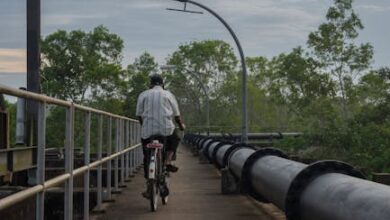The Catalan Derby Takes on New Meaning: Barcelona’s Imperative vs. Girona’s Dream

There are derbies, and then there are derbies that redefine the landscape. When Barcelona and Girona face off, it’s always been a clash of regional neighbours, but lately, it’s evolved into something far more potent: a battle for supremacy in La Liga itself. This isn’t just about local bragging rights anymore; it’s about two distinct footballing philosophies, two ambitious clubs, and two sets of fans caught in a whirlwind of expectation and historic dreams.
For decades, the script was predictable: Barcelona, the Catalan giant, would comfortably dispatch their smaller, less illustrious neighbours. But football, as we know, loves to throw up a curveball. Girona, under the astute guidance of Míchel, has transformed from a plucky underdog into a genuine title contender, playing some of the most exhilarating football in Europe. This fixture is no longer a foregone conclusion; it’s a high-stakes encounter that could genuinely shape the destination of the La Liga trophy. So, as these two titans of Catalan football prepare to lock horns, let’s dive into what makes this particular derby such a mouth-watering prospect.
The Catalan Derby Takes on New Meaning: Barcelona’s Imperative vs. Girona’s Dream
The narrative surrounding this match is layered, fascinatingly complex. On one side, you have Barcelona, a club steeped in history, success, and the relentless pressure that comes with wearing the blaugrana shirt. Under Xavi Hernández, they are in a period of transition, trying to blend their foundational principles of possession-based football with a pragmatic edge needed to win tough games. They need to win, not just for the points, but to reaffirm their status, to silence the doubters, and to inject much-needed confidence into their campaign.
Their season has been a rollercoaster of brilliant moments and frustrating inconsistencies. While their defence has, at times, shown resilience, the attacking flair that defines Barcelona hasn’t always been consistently present. Players like Robert Lewandowski are still capable of moments of magic, and the youthful exuberance of Lamine Yamal and Pedri offers glimpses of a bright future. Yet, the team often feels like it’s searching for its definitive identity, a consistent rhythm that allows them to dominate from start to finish. This game against Girona isn’t just another fixture; it’s a litmus test of their progress and their readiness to compete at the very top.
Girona: The Underdogs with a Roar
Then there’s Girona, a club that has captured the imagination of football fans worldwide. Their ascent has been nothing short of meteoric. They play with a swagger, an attacking verve, and a fearless attitude that belies their history. Míchel has instilled a brand of football that is both effective and incredibly entertaining, focusing on quick transitions, fluid movement, and an unwavering belief in their system. They don’t just participate; they dictate, they challenge, and they often dominate.
The strength of Girona lies not just in individual brilliance, though they have plenty of it in players like Artem Dovbyk, Savinho, and Aleix García, but in their collective spirit. They hunt in packs, support each other relentlessly, and play with an infectious joy that radiates from the pitch. For them, this match against Barcelona is not just another big game; it’s an opportunity to solidify their incredible season, to prove that their dream isn’t just a fleeting moment, but a sustained challenge for the very top of Spanish football. A win here would be a historic statement, one that would echo far beyond Catalonia.
Tactical Showdown: Xavi’s Blueprint vs. Míchel’s Masterclass
When it comes to the tactical battle, this promises to be a fascinating chess match. Barcelona, under Xavi, typically adheres to a 4-3-3 or a variant of it, prioritising possession, control in midfield, and creating chances through intricate build-up play. The likes of İlkay Gündoğan and Frenkie de Jong (if fit) will be crucial in dictating the tempo, breaking lines, and feeding the prolific Lewandowski. The wide play, often spearheaded by the explosive Lamine Yamal or the direct Raphinha, will be key to stretching Girona’s defence.
However, Xavi also faces a dilemma: how to cope with Girona’s high-octane press and quick counters without sacrificing their own attacking principles. He’ll likely rely on the defensive solidity of Ronald Araújo and the distribution skills of his centre-backs to build from the back under pressure. The midfield battle will be paramount; win that, and Barcelona can assert their dominance.
Girona’s Attacking Blitz
Míchel’s Girona, on the other hand, operates with a dynamic 4-2-3-1 or 4-3-3, characterized by relentless pressing, fluid attacking movements, and an ability to turn defence into attack in the blink of an eye. Their wingers, Savinho and Viktor Tsygankov, are incredibly direct, capable of beating defenders and delivering dangerous balls. Artem Dovbyk, their powerhouse striker, provides a focal point and a clinical finish. At the heart of it all is Aleix García, the midfield maestro who dictates play, creates opportunities, and anchors the team.
Girona isn’t afraid to take risks. They commit players forward, pressing high up the pitch to win the ball back quickly and launch rapid assaults. Their strategy will likely involve disrupting Barcelona’s build-up, exploiting any defensive spaces, and relying on their collective energy to overwhelm their opponents. The question for Girona will be whether they can maintain this intensity for the full 90 minutes against a team with Barcelona’s individual quality.
Key Battles Across the Pitch
Look out for several individual duels that could swing the game. The midfield battle between Barcelona’s creative hub (Gündoğan, Pedri) and Girona’s industrious engine room (Aleix García, Yangel Herrera) will be a tactical spectacle. How Barcelona’s full-backs cope with the pace and trickery of Savinho and Tsygankov will also be crucial. And, of course, the contest between Robert Lewandowski and Girona’s central defenders will be a classic striker-vs-defence showdown. Each of these mini-battles will contribute to the broader narrative of control and dominance.
Stats Don’t Lie (But They Don’t Tell the Whole Story Either)
Historically, Barcelona has the clear upper hand in head-to-head encounters against Girona. They’ve traditionally been the dominant force, with Girona only recently finding their footing in the top flight. However, recent form paints a very different picture. Girona’s ascent has been built on a foundation of consistent victories, often against teams many would consider their superiors. Their goal-scoring record is enviable, showcasing their attacking prowess, while their ability to grind out results against tough opposition highlights their growing maturity.
Barcelona’s stats, while still impressive, reveal some areas of concern. They might boast higher possession figures, but sometimes that possession doesn’t translate into enough clear-cut chances. Their defensive record has been strong at times, but individual errors have proven costly. Girona, on the other hand, might concede more shots, but their high-pressing game often recovers the ball in dangerous areas, turning defensive actions into attacking opportunities.
The statistics provide a quantitative backdrop, but football, especially a derby, is often decided by intangibles: momentum, belief, and the sheer will to win. Girona enters this match with a palpable sense of confidence and a desire to prove that their sensational season is no fluke. Barcelona, conversely, carries the weight of expectation and the need to reassert their dominance. This emotional weight can sometimes override what the numbers suggest, making for an unpredictable and thrilling contest.
Conclusion
This match between Barcelona and Girona isn’t just another fixture in the La Liga calendar; it’s a symbolic clash. It represents the old guard desperately clinging to its throne against a vibrant, audacious challenger who is not only knocking on the door but threatening to kick it down. The tactical battle will be immense, the individual duels fascinating, and the atmosphere, no doubt, electric.
Whether Barcelona can leverage their experience and individual quality to halt Girona’s incredible charge, or if Girona’s collective spirit and fearless approach will lead them to another historic victory, remains to be seen. One thing is for sure: this Catalan derby is more than just a game. It’s a statement, a testament to the ever-evolving drama of football, and a match that promises to deliver excitement, tension, and perhaps, a pivotal moment in the race for the La Liga title. We’re all in for a treat.





